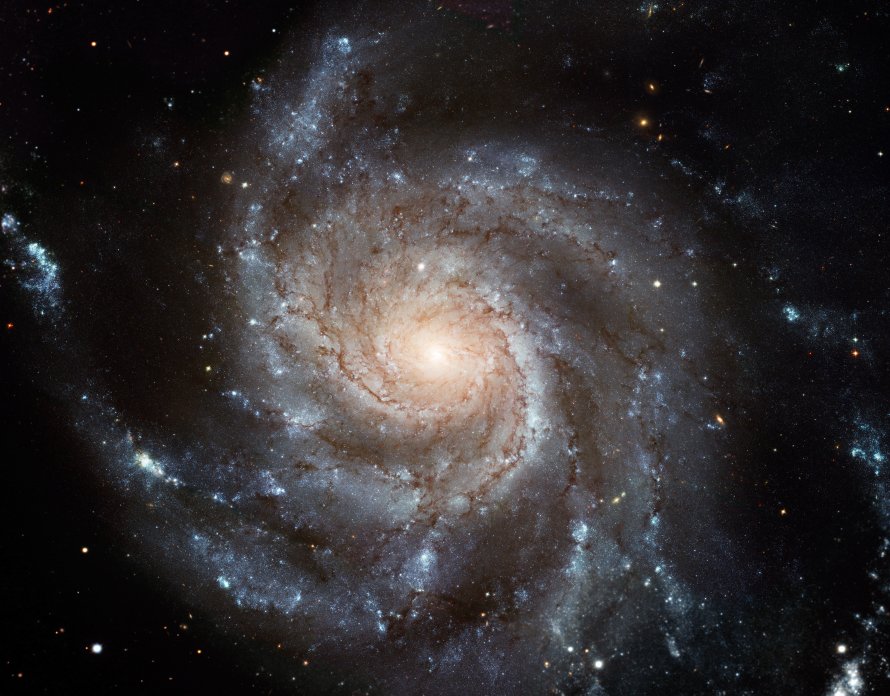M101 (NGC 5457) - Pinwheel Galaxy
Messier 101 (NGC 5457), also known as the Pinwheel Galaxy, is a spiral galaxy located in the constellation Ursa Major in the M101 Group of galaxies. M101 is 21000000 light years away from Earth.
M101 is best viewed during early spring, is magnitude 7.9, and can be viewed with binoculars. M101 is 28.8' x 27' in apparent size. For reference, the full moon is 30'.
Observing difficulty: Hardest
- Name:
- Pinwheel Galaxy
- Type:
- spiral galaxy
- Constellation:
- Ursa Major
- NGC or IC:
- NGC 5457
- Magnitude:
- 7.9
- Viewing:
- binoculars
- Size:
- 28.8' x 27'
- Distance (light years):
- 21000000 LY
- RA:
- 14h 3.3m
- Dec:
- 54 22'
- Season:
- early spring
- Galaxy group:
- M101 Group
- Messier Marathon #:
- 44
* The naked eye can see up to magnitude ~7-8 objects under ideal dark sky conditions.
The Pinwheel Galaxy
Messier 101 (M101), also known as the Pinwheel Galaxy, is a spectacular face-on spiral galaxy located in the northern constellation Ursa Major. Discovered by Pierre M?chain on March 27, 1781, it was subsequently catalogued by his colleague Charles Messier. Owing to its face-on orientation relative to Earth and its grand design pattern, the Pinwheel Galaxy is a favorite subject for both professional astronomers and amateur skywatchers alike.
Physical Characteristics of Messier 101
Messier 101 has a diameter of about 170,000 light-years, making it nearly twice the size of our Milky Way galaxy. It possesses a distinctive spiral structure with pronounced arms that splay outwards, winding from its bright core. These arms are abundant with star-forming regions, which are evident in the pinkish nebulae that punctuate the bluish lanes of young stars. Dark dust lanes, visible against the backdrop of the galaxy's luminous body, accentuate the spiral pattern.
The Pinwheel Galaxy is notable for its high population of HII regions, areas of ionized atomic hydrogen that typically encompass star-forming regions. In fact, one of these regions in M101 was the host of the supernova SN 2011fe, one of the most studied stellar explosions in the history of astronomy.
Magnitude and Distance
Messier 101 is located at a distance of approximately 21 million light-years from Earth. It has an apparent magnitude of 7.9, making it a challenging target for naked-eye observations, even under excellent viewing conditions. However, its brightness exceeds that of many other spiral galaxies and is quite impressive given its considerable distance.
Finding and Observing Messier 101
The Pinwheel Galaxy is found in the constellation Ursa Major, the same constellation that is home to the famous asterism known as the Big Dipper. M101 is positioned near the handle of the Big Dipper, a bit to the east of the star Mizar.
Although challenging to see without optical aid, a small telescope or binoculars will reveal the presence of M101 as a hazy, luminous spot. With larger telescopes, the galaxy's spiral structure begins to emerge, especially under dark skies. To discern the intricate detail within the spiral arms, such as the nebulae and stellar clusters, requires the resolving power of larger amateur telescopes or long-exposure astrophotography.
The opportunity to observe the Pinwheel Galaxy offers an incredible glimpse into the grandeur of spiral galaxies. With its clear spiral structure, active star-forming regions, and dynamic history of stellar events, M101 remains a captivating subject in the quest to understand our universe.



